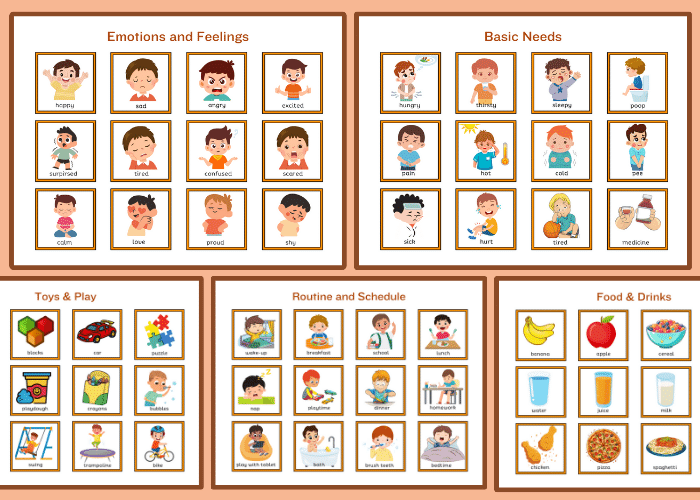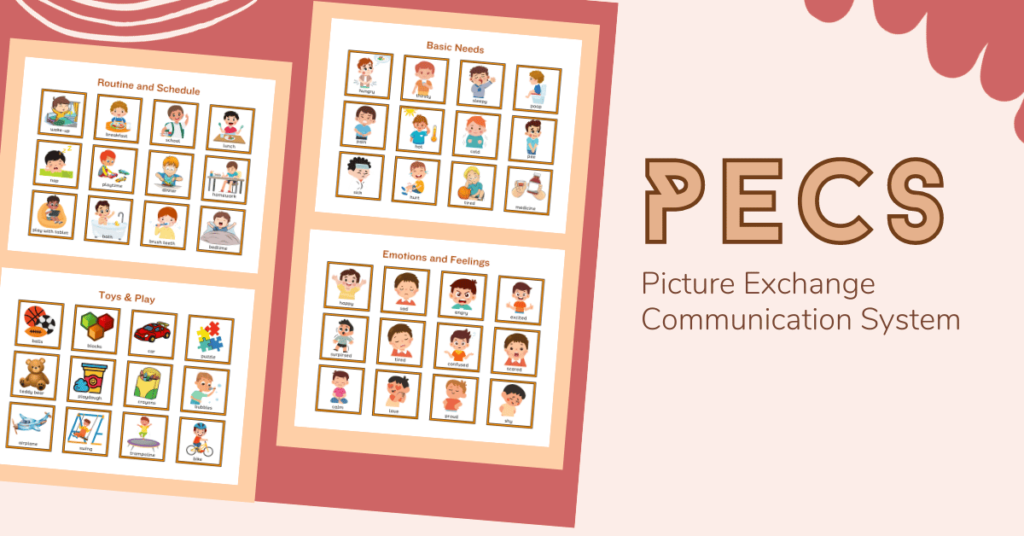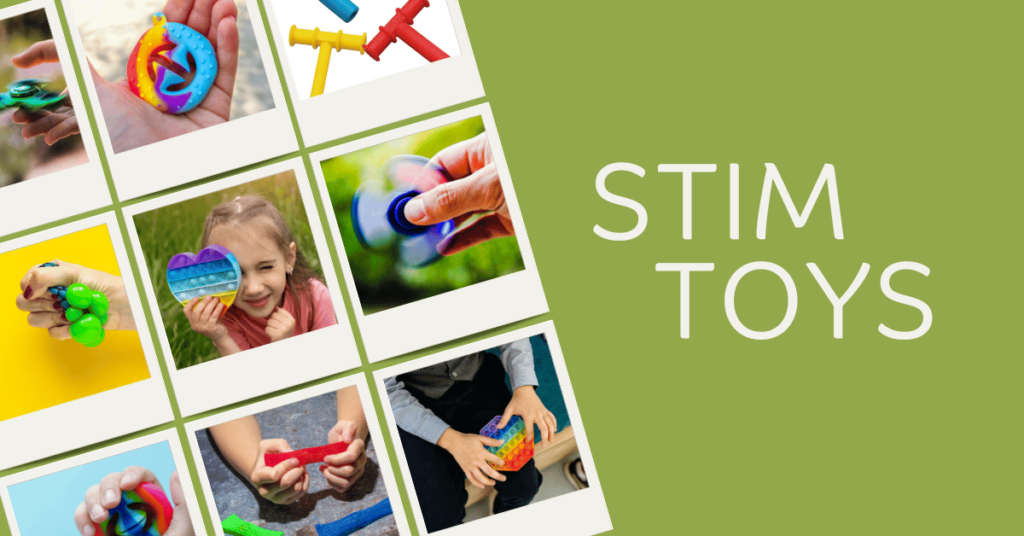Disclosure: This post may contain affiliate links. As an Amazon Associate, I earn from qualifying purchases. This means that if you click on a link and make a purchase, we may earn a commission at no additional cost to you. We only promote products we truly believe in, and your support helps us continue providing valuable content to our readers.
- I. Introduction
- II. Understanding PECS
- III. Preparing for PECS at Home
- IV. Creating a PECS Picture System
- V. Teaching and Implementing PECS
- VI. Addressing Common PECS Challenges
- VII. Tracking Progress and Adaptations
- VIII. Conclusion: Empowering Communication, One Picture at a Time
- IX. Frequently Asked Questions (FAQ)
I. Introduction
Parenting a child with communication difficulties can be challenging. The Picture Exchange Communication System (PECS) can be a game-changer. This article will guide you through implementing PECS pictures at home. It can help empower your child to express themselves effectively.
II. Understanding PECS
PECS is a proven communication method designed for individuals with limited verbal skills. It is often used with children on the autism spectrum. It involves using pictures or symbols to convey thoughts, needs, and desires. An essential principle is that it’s not just about communication. It also promotes social and cognitive development.
III. Preparing for PECS at Home
Implementing PECS at home is a process that requires careful preparation. You must take the following steps to foster an ideal environment for your child to succeed with PECS:
A. Educate Yourself.
Learn the basics of PECS through books, online resources, or workshops. Learning about PECS is your first step toward effectively implementing it at home:
- Read Books and Manuals. There are several well-regarded books and manuals available on PECS. These resources offer in-depth insights, step-by-step guides, and practical tips.
- Online Resources. Explore trusted websites, blogs, and forums that focus on PECS picture. They provide articles, videos, and forums where parents share their experiences and knowledge.
- Attend Workshops and Training. Consider attending workshops or training sessions conducted by experts in PECS. These events offer hands-on experience and a chance to ask questions.
B. Assess Your Child’s Needs
Understand your child’s specific communication challenges, strengths, and preferences. Every child is unique. Understanding your child’s individual needs and abilities is crucial:
- Observe Your Child. Spend time observing your child’s communication patterns. Note how they currently express their needs, even if it’s non-verbal.
- Identify Strengths and Interests. Recognize your child’s strengths and interests. What motivates them? What are their favorite activities, toys, or objects?
- Consult with Professionals. Engage with speech therapists, special educators, or behavioral specialists. Gain a deeper understanding of your child’s communication challenges and strengths. They can provide valuable insights and assessments.
C. Gather Necessary Supplies.
Get the materials needed, such as PECS picture cards and a communication binder. Prepare a designated space for communication. Having the suitable materials is essential for a successful PECS implementation:
- Picture Cards. Create picture cards representing the items, activities, and needs your child will likely want to communicate. These cards should be clear, visually appealing, and meaningful to your child. There are also Ready-to-Use Picture Cards available online.
- Communication Binder. Invest in a communication binder or notebook. This binder will keep the PECS picture cards organized for easy access.
- Designated Communication Space. Dedicate a specific space in your home for communication activities. This space should be quiet. It should be free from distractions and easily accessible to your child.
IV. Creating a PECS Picture System
Implementing PECS at home requires careful planning and organization. The PECS system is the heart of this approach. It empowers your child to communicate effectively. Here’s a more in-depth look at how to create an effective PECS system:
A. Select Appropriate Symbols
Selecting the correct symbols is a crucial first step. It’s essential to choose pictures or symbols that resonate with your child. It makes them more inclined to engage with the system. Here’s how to go about it:
- Identify Preferred Items and Activities. Start by understanding what motivates and interests your child. These could be their favorite toys, foods, activities, or people.
- Customize Symbols. Once you know your child’s preferences, create or obtain symbols representing these items or activities. You can find pre-made PECS pictures or create your own. Ensure these symbols are clear, recognizable, and meaningful to your child.
- Vary Symbol Types. It’s beneficial to have a mix of symbols. Include real photographs, line drawings, or even 3D objects. This variety can cater to different learning styles and preferences.

Downloads Pre-made PECS Pictures
B. Organize Communication Binder
A well-organized communication binder is the backbone of the PECS system. It ensures that PECS pictures are readily accessible for your child. Here’s how to set it up effectively:
- Select a Suitable Binder. Choose a binder that’s the right size for your child, easy to handle, and durable. Many families use binders with Velcro strips on the pages to attach symbols.
- Categorize Pictures. Organize the PECS pictures into categories such as “Food,” “Toys,” “Actions,” and “People.” This systematic arrangement helps your child quickly locate the pictures they need.
- Use Visual Labels. Attach visual labels on each page or category to help your child understand what’s inside. For instance, you can add a picture of food on the “Food” category page.
- Make It Interactive. Encourage your child to help set up and organize the binder. It can foster a sense of ownership and independence in using the system.
You can also opt to purchase Ready-to-Use Visual Communication Books available online. This convenient option provides instant access to a curated collection of visuals designed to streamline your communication needs.
C. Practice with Your Child
Introducing the PECS system to your child is a gradual process. It requires patience and encouragement. Here’s how to practice effectively:
Start Simple. Begin with a small selection of PECS pictures. Focus on items or activities your child is most interested in. Having too many pictures at once can be overwhelming.
- Modeling. Model how to use the PECS system by selecting a symbol. Show how to place it on the “communication strip” or wherever you’ve designated for it. And then obtain the desired item or action.
- Repetition and Reinforcement. Practice using the system daily. Encourage your child repeatedly to select a PECS picture to communicate. When they do so successfully, provide immediate positive reinforcement, such as a preferred item or praise.
- Be Patient and Observant. Every child progresses at their own pace. Observe your child’s reactions and adapt your approach as needed. Some children may grasp PECS quickly, while others may need more time and support.
Creating an effective PECS system involves personalization, organization, and consistent practice. The system should evolve with your child’s communication needs and preferences. It will help make it a valuable tool for enhancing their ability to express themselves.
V. Teaching and Implementing PECS
Once you’ve established your PECS system, the next step is teaching your child how to use it. The following three key strategies are central to this process:
A. Modeling
Demonstrate how to use the system. Modeling is an essential first step in teaching PECS. It involves showing your child how to use the system effectively. Here’s how to do it:
- Select a PECS picture. Begin by choosing a picture that represents something your child might want. It could be a favorite toy, a snack, or an activity.
- Point and Speak. Point to the selected PECS picture while simultaneously saying the word it represents. For instance, if you’re pointing to a picture of a ball, say “ball” as you do.
- Prompt Interaction. Encourage your child to take the PECS picture from you. If unsure or hesitant, gently guide their hand to help them remove the picture.
- Immediate Reinforcement. Once your child hands you the PECS picture, promptly fulfill their request. If it’s a toy, give them the toy. If it’s a snack, provide the snack.
Modeling should be a regular part of your interaction. Ensure your child grasps the connection between the PECS picture, the word, and the desired item or action.
B. Prompting
Encourage your child to use the system by providing guidance. Prompting is guiding your child to use PECS when they need help to initiate it. It’s a critical step in helping them become more independent communicators.
- Offer Visual and Verbal Cues. Gently guide your child’s attention toward the communication binder. You can do this by saying, “What do you want?” while pointing to the binder.
- Use Hand-Over-Hand Assistance. If your child doesn’t respond to verbal cues, provide physical guidance. Place their hand on the binder, help them select a PECS picture, and hand it to you.
- Maintain Patience. Be patient and flexible. If your child appears frustrated or disinterested, take a step back and try again later. Encourage, but don’t force.
The goal is to reduce prompting as your child becomes more proficient in using the system.
C. Reinforcement
Celebrate successes with praise and rewards. Reinforcement is a fundamental element of teaching and implementing PECS. It involves celebrating and rewarding your child for their communication efforts:
- Praise and Encouragement. Each time your child uses a PECS picture to communicate a need or desire, offer praise and positive feedback. Express your excitement and pride in their achievement.
- Immediate Fulfillment. Ensure that your child’s requests are met promptly. If they request a toy, give it to them. It helps them understand the power of communication.
- Use of Preferred Rewards. Besides verbal praise, you can also use preferred rewards. You can give small treats, extra playtime, or other incentives. It is to reinforce positive communication behavior.
Consistent reinforcement creates a positive association between communication and positive outcomes. It can help motivate your child to continue using the PECS pictures.
Teaching and implementing PECS requires patience, consistency, and a nurturing approach. By modeling, prompting, and reinforcing, you give your child the tools and motivation they need to become effective communicators. It can motivate them to engage more fully with the world around them.
VI. Addressing Common PECS Challenges
Introducing PECS pictures can bring about a transformative change in your child’s communication abilities. However, like any new skill, there are common challenges you may encounter along the way. It’s essential to understand and address these challenges effectively:
A. Resistance
Some children may be initially resistant to PECS; be patient and consistent. Resistance to change is a natural reaction. Some children might initially resist using the PECS system. Here’s how to handle this challenge:
- Assess the Source of Resistance. Try to understand why your child is resistant. It could be due to unfamiliarity or frustration. It could be due to a preference for their existing communication methods.
- Maintain Patience. Encourage your child gently but persistently. Avoid pressure or coercion, as this can lead to more resistance.
- Make It Fun. Incorporate elements of fun and play into the PECS process. Use colorful and engaging PECS pictures. Incorporate games that involve selecting and using these pictures.
- Consistency is key. Be consistent in your use of PECS pictures. The more your child experiences its benefits, the more likely they will embrace it.
B. Limited Initiation
If your child struggles to initiate communication, work on prompting and motivation Limited initiation means your child may not initiate communication using the PECS system independently. Here’s how to address this challenge:
- Promote Opportunities. Create situations where your child is encouraged to initiate communication. Place preferred items or activities where they can see and access the corresponding PECS picture.
- Use Visual Prompts. Visual cues, such as putting a PECS picture within their reach, can encourage them to initiate communication. Over time, decrease the proximity of the pictures.
- Incorporate Natural Routines. Integrate PECS pictures into daily routines and activities, like mealtime or playtime. It can make initiation more natural.
- Provide Motivation. Ensure that your child has a solid motivation to use PECS. They’re more likely to initiate if they see the value in communicating through this system.
C. Generalization
Help your child generalize PECS from home to other environments and with different people. Generalization is applying the skills learned at home to other environments and with different people. Here’s how to facilitate this crucial aspect of using PECS pictures:
- Introduce Variation. Gradually introduce changes and variations in the environment at home. Use them in different rooms, times, and activities.
- Community Involvement. Collaborate with educators, therapists, or caregivers outside the home. It can help ensure consistent use of PECS across different settings.
- Community Outings. Take your child to various places and encourage them to use PECS to communicate their needs. Ensure you have the communication binder or PECS pictures on hand.
- Social Modeling. Encourage your child to observe and interact with peers or other children who use PECS. Social modeling can be very effective in promoting generalization.
Remember, each child’s progress is unique. Troubleshooting these common challenges may take time. Be patient, observant, and flexible in your approach. Seek support from professionals or support groups if needed. The ultimate goal is to help your child use PECS as a reliable and effective tool for communication. Help your child use them in various settings and with multiple people.
VII. Tracking Progress and Adaptations
As you implement PECS at home, tracking your child’s progress is crucial. Make adaptations as needed. Here are vital steps to ensure that your child’s communication journey remains effective and supportive:
A. Data Collection
Keep records of your child’s communication attempts and successes. Data collection is essential for understanding your child’s progress. It allows them to make informed decisions regarding their PECS system:
- Create a Communication Journal. Maintain a journal where you record your child’s communication attempts and successes. Note what they requested, when, and their level of independence.
- Use Visual Aids. Use visual aids, such as charts or graphs. It can help you track trends and patterns in your child’s communication development. Create charts to document milestones, like the first independent use of a PECS picture.
- Frequency of Communication. Note how often your child uses the PECS system and in which situations. It can help identify where they may need more support or practice.
- Share with Professionals. Share your data with your child’s teachers, therapists, or other professionals. They can provide insights and guidance based on the collected information.
B. Regular Reviews
Periodically review and adapt the PECS system as your child’s needs change. The needs and abilities of children using PECS can change over time. It is essential to review and adapt the PECS system to ensure it remains effective:
- Set Review Intervals. Establish a schedule for reviewing your child’s communication system. It could be every few weeks or as needed.
- Consult with Professionals. Seek input from speech therapists, educators, or behavioral specialists for guidance on system adaptations. They can provide valuable insights.
- Updating Pictures. As your child’s interests and preferences evolve, you may need to add new pictures. You need to add to represent their changing needs and wants.
- Modify Structure. Adjust the organization of the communication binder if your child has outgrown the current setup. You need to adjust if they need a more complex system.
- Consistency is Key. Ensure consistency in the use of PECS across all settings. Use them at home, school, or therapy sessions. Review the system used outside the home to ensure alignment.
It’s important to remember that the PECS system is a dynamic tool. It should evolve alongside your child’s communication skills and requirements. Track progress and adapt the system. By doing so, you can provide support and enhance your child’s communication abilities. Through consistent monitoring and adjustments, you can ensure the system remains a reliable and tailored tool for your child’s unique needs.
VIII. Conclusion: Empowering Communication, One Picture at a Time
The journey of parenting a child with communication challenges may seem daunting. But it’s paved with hope and progress. The Picture Exchange Communication System (PECS) stands as a beacon. It offers a bridge to the world of effective communication for your child. As a parent, you are the guiding force behind your child’s journey toward effective communication. Your role is pivotal in paving the way for success.
IX. Frequently Asked Questions (FAQ)
Is PECS only for children with autism?
No, while PECS is commonly used with children on the autism spectrum, it can benefit anyone with communication challenges.
How long does it take to see progress with PECS?
Progress varies for each child. Some may show improvement within weeks. For others, it may take several months of consistent effort.
Can I create my own PECS picture cards?
Yes, you can create custom picture cards to suit your child’s needs and interests. Ensure they are clear and understandable.
What if my child prefers verbal communication over PECS?
Encourage verbal communication while using PECS as a supplementary tool. PECS can support and enhance verbal language development.
Are there any age restrictions for implementing PECS?
PECS can be introduced at a young age but is adaptable for individuals of various ages. It all depends on their communication needs.



